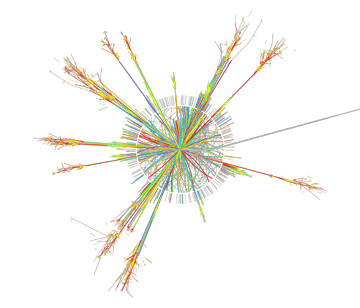 Preliminary anthropology research in French Polynesia seems to confirm what psychology and sociology researchers have observed about domestic violence in general: There are two different types. One kind endures and escalates, while the other gradually fades away after a few years.
Preliminary anthropology research in French Polynesia seems to confirm what psychology and sociology researchers have observed about domestic violence in general: There are two different types. One kind endures and escalates, while the other gradually fades away after a few years.
The findings are those of SMU’s Victoria Lockwood, who for three decades has studied the lives of women on the chain of South Pacific islands that includes the tropical paradise of Tahiti.
Few anthropologists study domestic violence. What Lockwood has found initially confirms the existence of “battering,” which is long-lived, versus “situational couple violence,” which is short-lived.
“If we don’t acknowledge there are two different kinds of domestic violence, then we’ll never understand what the causes are,” says Lockwood. “The causes are very different, so if we wish to devise policies or social programs, we need to be doing two different things to address the issues.”
Lockwood is a cultural anthropologist and associate professor in the Anthropology Department of SMU’s Dedman College. For 28 years she has studied the impact of modernization and globalization on the women of Tahiti and its tiny rural neighbors, Tubuai and Rurutu.
Lockwood’s research took a turn, however, when the women began disclosing that arguments with their husbands at times resulted in physical violence. The revelations intrigued Lockwood. Now she is investigating the prevalence, causes, meanings and consequences of domestic violence on its victims on the islands. The research is funded by a three-year, $128,000 grant from the National Science Foundation.
 Lockwood leaves in June for a month-long stay on Tubuai and Rurutu. She first traveled there in 1981 as a graduate student for her doctoral degree at UCLA. In the past three decades Lockwood has made seven trips to the islands, in particular Tubuai. The most recent one was in 2005, when she conducted preliminary research, interviewing husbands and wives from 25 families about domestic violence in their lives.
Lockwood leaves in June for a month-long stay on Tubuai and Rurutu. She first traveled there in 1981 as a graduate student for her doctoral degree at UCLA. In the past three decades Lockwood has made seven trips to the islands, in particular Tubuai. The most recent one was in 2005, when she conducted preliminary research, interviewing husbands and wives from 25 families about domestic violence in their lives.
“Because I’ve worked on this island so long, I know these families, and they’ve already talked to me about abuse,” Lockwood says.
What kind of domestic violence?
The islands are a fairly gender-egalitarian society, she says. Domestic violence is no more common there than anywhere else. The women expressed distress to Lockwood that their husbands hit them, but said the assaults gradually stop after the early years of marriage.
“If you ask the wives, ‘Has your husband ever hit you or shoved you or kicked you?’ the vast majority will say that it’s happened, and that they’ve probably done it themselves, but that it wasn’t a pattern,” Lockwood says. “They’ll say, ‘Oh, he had just lost his job or he was stressed out from this or that, and it doesn’t happen all the time, and it went away.’ If you asked them ‘Is this domestic violence?’ they would say, ‘No.'”
That’s not the stereotype of domestic violence, Lockwood notes, citing the widely held belief that one incident of abuse indicates more to come.
For example, consider talk-show host Oprah’s advice this spring to pop star Rihanna, telling her to break up with boyfriend Chris Brown because he would surely hit her again.
“The word on the street, at least in American society, is that domestic violence doesn’t go away, ‘Once an abuser, always an abuser,’ and that the abuse escalates over time,” Lockwood says. “But that wasn’t the case in Tahiti. And that’s what got me interested in looking at the issue in Tahitian society.”
Psychologists and sociologists have reported the distinction between short- versus long-lived domestic abuse for about 15 years. They describe situational couple violence as sporadic domestic abuse that occurs early in a marriage as a couple attempts to work out balance-of-power issues and decision-making. The violence is initiated by either the husband or wife, then fades away.
Battering is typically enduring, and the husband is normally the aggressor. The violence usually escalates, with the husband obsessed to control every aspect of his wife’s behavior, using verbal as well as physical tactics, Lockwood says.
“In Tubuai, a lot of young couples describe the early years of marriage as very rocky, very difficult, and then things get much better,” she says.
Anthropologically, Lockwood says, the work is relevant to the study of violence in general.
“In a lot of societies, various acts of violence, even between spouses, are considered to be OK and legitimate. In some societies that’s not the case, and other acts are considered terrible and horrible. But it’s all violence,” Lockwood says. “I hope to understand more about how different cultures define what violence is, and what is an appropriate relationship between husbands and wives.” — Margaret Allen
Related links:
Victoria Lockwood
Department of Anthropology
Dedman College of Humanities and Sciences






 • CERN is indeed an international particle physics laboratory near Geneva, Switzerland where hundreds of scientists from around the world study the fundamental laws of nature.
• CERN is indeed an international particle physics laboratory near Geneva, Switzerland where hundreds of scientists from around the world study the fundamental laws of nature.


